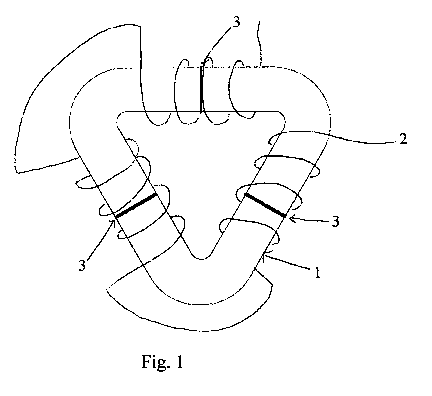Some of the information on this Web page has been provided by external sources. The Government of Canada is not responsible for the accuracy, reliability or currency of the information supplied by external sources. Users wishing to rely upon this information should consult directly with the source of the information. Content provided by external sources is not subject to official languages, privacy and accessibility requirements.
Any discrepancies in the text and image of the Claims and Abstract are due to differing posting times. Text of the Claims and Abstract are posted:
| (12) Patent Application: | (11) CA 2678606 |
|---|---|
| (54) English Title: | A REACTOR CORE |
| (54) French Title: | COEUR DE REACTEUR |
| Status: | Deemed Abandoned and Beyond the Period of Reinstatement - Pending Response to Notice of Disregarded Communication |
| (51) International Patent Classification (IPC): |
|
|---|---|
| (72) Inventors : |
|
| (73) Owners : |
|
| (71) Applicants : |
|
| (74) Agent: | MARKS & CLERK |
| (74) Associate agent: | |
| (45) Issued: | |
| (86) PCT Filing Date: | 2008-02-20 |
| (87) Open to Public Inspection: | 2008-08-28 |
| Examination requested: | 2012-03-22 |
| Availability of licence: | N/A |
| Dedicated to the Public: | N/A |
| (25) Language of filing: | English |
| Patent Cooperation Treaty (PCT): | Yes |
|---|---|
| (86) PCT Filing Number: | PCT/SE2008/000138 |
| (87) International Publication Number: | WO 2008103104 |
| (85) National Entry: | 2009-08-17 |
| (30) Application Priority Data: | ||||||
|---|---|---|---|---|---|---|
|
A reactor core is formed in an essentially triangular shape. Such a reactor core shape can advantageously be obtained by winding a strip of electromagnetic material, such as a strip of transformer plate, a number of windings into a triangular shape.
Un cAEur de réacteur est formé selon une forme sensiblement triangulaire. Une telle forme de cAEur de réacteur peut être avantageusement obtenue par enroulement d'une bande de matériau électromagnétique, telle qu'une bande de plaque de transformateur, d'un certain nombre d'enroulements en une forme triangulaire.
Note: Claims are shown in the official language in which they were submitted.
Note: Descriptions are shown in the official language in which they were submitted.

2024-08-01:As part of the Next Generation Patents (NGP) transition, the Canadian Patents Database (CPD) now contains a more detailed Event History, which replicates the Event Log of our new back-office solution.
Please note that "Inactive:" events refers to events no longer in use in our new back-office solution.
For a clearer understanding of the status of the application/patent presented on this page, the site Disclaimer , as well as the definitions for Patent , Event History , Maintenance Fee and Payment History should be consulted.
| Description | Date |
|---|---|
| Time Limit for Reversal Expired | 2014-02-20 |
| Application Not Reinstated by Deadline | 2014-02-20 |
| Deemed Abandoned - Failure to Respond to Maintenance Fee Notice | 2013-02-20 |
| Letter Sent | 2012-04-12 |
| Request for Examination Received | 2012-03-22 |
| Request for Examination Requirements Determined Compliant | 2012-03-22 |
| All Requirements for Examination Determined Compliant | 2012-03-22 |
| Amendment Received - Voluntary Amendment | 2011-10-12 |
| Inactive: Cover page published | 2009-11-12 |
| Inactive: Notice - National entry - No RFE | 2009-10-17 |
| Inactive: First IPC assigned | 2009-10-13 |
| Application Received - PCT | 2009-10-13 |
| Inactive: Declaration of entitlement - PCT | 2009-08-19 |
| National Entry Requirements Determined Compliant | 2009-08-17 |
| Application Published (Open to Public Inspection) | 2008-08-28 |
| Abandonment Date | Reason | Reinstatement Date |
|---|---|---|
| 2013-02-20 |
The last payment was received on 2011-12-19
Note : If the full payment has not been received on or before the date indicated, a further fee may be required which may be one of the following
Please refer to the CIPO Patent Fees web page to see all current fee amounts.
| Fee Type | Anniversary Year | Due Date | Paid Date |
|---|---|---|---|
| Basic national fee - standard | 2009-08-17 | ||
| MF (application, 2nd anniv.) - standard | 02 | 2010-02-22 | 2009-08-17 |
| MF (application, 3rd anniv.) - standard | 03 | 2011-02-21 | 2010-12-20 |
| MF (application, 4th anniv.) - standard | 04 | 2012-02-20 | 2011-12-19 |
| Request for examination - standard | 2012-03-22 |
Note: Records showing the ownership history in alphabetical order.
| Current Owners on Record |
|---|
| HEXAFORMER AB |
| Past Owners on Record |
|---|
| AGNE FAELLDIN |